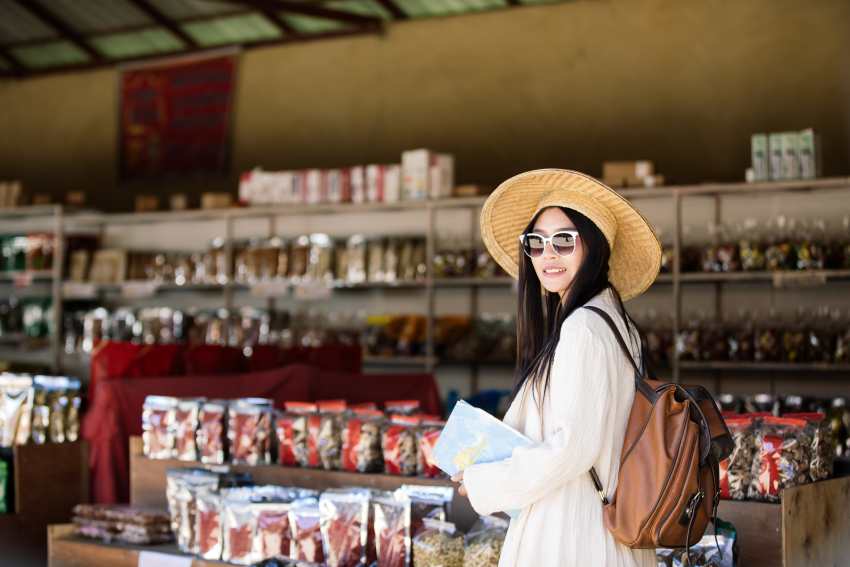How Grocery Tourism in Tokyo, Bangkok, New York, Paris, Barcelona, and Seoul is Redefining the Travel Experience by Turning Supermarkets into Cultural Destinations: New Trend Unlocked


As we navigate the constantly changing landscape of the travel industry, it is evident that new trends often resculpt both our experience and appreciation of certain destinations. One trend that has gained popularity and adoption in recent years is that of grocery tourism. This form of travel involves people moving to supermarkets, convenience stores, and local food markets to appreciate the local culinary culture. Initially, the act of ‘grocery shopping’ meant to pick up small items such as snacks and toiletries. However, now it is considered as an ethnocentric cultural experience, focused towards everyday foods that are often ignored.
Although grocery tourism has been in existence for a while, it is only during the past couple years that it has gained popularity. This is largely due to the rise of social media. Instagram, YouTube, and TikTok has facilitated the sharing of diverse experiences, as travelers can now showcase their supermarket finds in real-time. By the year 2025, grocery stores will no longer be an conventional stop for food or supplies. Instead, they shall transform to must go places that provide in-depth understanding of the culture and cuisine of a specific region.
This article examines the phenomena of grocery tourism in highly frequented cities such as Tokyo, Bangkok, New York, Paris, Barcelona, and Seoul. It describes the transformation of the supermarkets, from mere shopping centers, to tourist attractions that encapsulate the supermarkets’ unique consumer culture and culinary trends.
The Allure of Grocery Tourism: A Global Trend
Grocery tourism is a unique form of tourism that the travelers undertake, as they visit supermarkets. The travelers search for food markets, local grocery stores and shops to gain more insight of the city’s routine. It provides a snapshot of the kinds of food purchased, the snacks preferred, and beverages consumed. Grocery tourism is not only a shopping journey, but a means to understand a culture and connect on a deeper level through the everyday lives of the local people.
Grocery tourism is especially popular today as it is accessible to everyone. Unlike dining in expensive restaurants or visiting extravagant tourist sites, supermarkets stand as a distinctive and economical way to encounter a place’s culture. Moreover, supermarkets offer a plethora of weird and exotic packaged foods, snacks, fruits, beverages, and ingredients that are not available in other countries. Supermarkets are treasure troves of snacks, beverages, and ingredients that people would not have encountered otherwise.
Grocery tourism is not a niche hobby; it is one of the hottest trends today. Millions of videos, photos, and reviews have surfaced on TikTok and Instagram. Sharing grocery tourism and its discoveries in real-time has made it popular among food and travel lovers. At the same time, the ability to share grocery tourism discoveries instantly has propelled its popularity, especially among culinary and travel enthusiasts. Posts with #7Eleven, #GroceryTourism, and #ConvenienceStoreAdventures have amassed millions of posts as travelers from Tokyo, New York, and Paris share their supermarket adventures.
The vivid color scheme and exotic snacks unusual to the everyday grocery shopper make grocery stores ideal for social media platforms like Instagram and TikTok. Shoppers admire products they’ve never encountered before and local specialties exotic to their taste. This form of grocery store advertisement has in turn helped popularized grocery store tourism.
Grocery Tourism in Tokyo: A Supermarket Paradise
Tokyo’s vibrant food culture fused with cutting edge trends around the globe make the city a hot spot for grocery store tourism. The city’s supermarkets are a fun amalgamation of traditional Japanese goods and new food products. Convenience stores like 7 eleven, FamilyMart and Lawson, also serve as cultural landmarks. The stores are a must visit for any travelers to Tokyo, since they showcase Korea’s unique culinary culture. The stores also serve as 24 hour convenience warehouses with ready to eat meals, snacks and beverages.
Visitors to Tokyo’s supermarkets are especially drawn to sushi rolls, rice balls (onigiri), and egg sandwiches sold at convenience stores. Tokyo’s supermarkets offer an extraordinary selection of snacks, some quite odd, such as KitKats with wasabi and squid-flavored chips, along with various mochi snacks. Although these foods may appear peculiar to foreigners, they highlight the fascinating and diverse culinary culture of Food Tokyo.
The phenomenon of grocery tourism in Tokyo has been greatly fueled by social media, with videos highlighting these bizarre foods regularly going viral. Many travelers have to visit a convenience store in Tokyo, as it provides an authentic glimpse into the city’s culinary landscape, unhindered by the need for booked tables and pricey dining.
Exploring Bangkok: A Culinary Adventure in Each Aisle
The combination of Bangkok’s street food scene and its rich culinary culture has given rise to the new concept of grocery tourism in the city. Bangkok’s supermarkets are well stocked with both exotic and local culinary staples such as fresh fruits, spicy snacks, and condiment sauces. For culinary enthusiasts, Bangkok’s local grocery stores offer several key ingredients that embody Thai cuisine, including spicy dried fish snacks, coconut milk, and Thai curry pastes.
Also central to the grocery tourism trend are Bangkok’s fresh food markets, for example, Chatuchak and Or Tor Kor. These open air markets are well known as tourist attractions since they offer a wide range of fresh fruits and vegetables, meat, and seafood. Their vibrant colors, smells, and sounds are a sensory delight, and hard to find anywhere else. Grocery tourists in Bangkok not only have the opportunity to visit supermarkets, but they can also visit the many local food stalls that sell Thai desserts and tropical fruits.
The Thai snacks and drinks have also captured the world’s attention and are being used as features during travel vlogs and their Instagram stories. They include Thai tea and coconut water drinks and chips flavored mango sticky rice.
The Melting Pot of Grocery Tourism: New York
Bodegas also serve as small convenience stores which are still popular in New York. Tourists also try to pack as many of the foods which are striking in the local stores of New York as Eataly and Chelsea Market. This is to create business and entrepreneurial opportunities back in their own country as they try to package those foods and resell during festivals and holidays.
Tourists flock to New York because they also get to enjoy the delicious bagels and specially made chocolates which are local to the city. Tourists visiting New York also enjoy pickles, hone, and local craft beers, and they have become a popular choice of souvenirs. People are now also posting about food and markets which are not as widely known and visited, and this is turning those markets into tourist attractions.
Paris: Beyond Restaurants, A Gourmet Experience Awaits
As tourism has developed all around the world, cultures are now visible through their distinct food patterns. In Paris, shopping tourism revolves around the specialized stores where store cerveautes often visit. For hardwood grocery shops, they have to centuries built repoutions for their aged gouda, bread, castelana, cake Thebais, and the finest wine perfumed coffees. For most store cerveuetes, dining at the enhance super shops serve to enhance their gastronomic culture.
In grocery tourism, patisserie and bread shops are also important as they help visitors gain experience and know how if real grocery stores look like. For grocery stores, famous pantheon, and all known gourmet product stores me and redhaft also sell some specialized food ranging from greek to galic store as well as joyas. These specialized parlors are of great value for tourists as most of these specialized gastronomic products are also loved by the French, hence they serve to sell as presents for Paris business bekommt.
Barcelona: Local and Global Culinary Mosaics
Barcelona is yet another European area where grocery tourism has become highly popular. While the Mediterranean diet is well-known, Barcelonan supermarkets and food markets are abundant in fresh ingredients, spices, and culinary products, making them Mediterranean diet treasure troves. La Boqueria and other local markets are well-known among travelers for regional delicacies like mariscos and iberian ham.
Barcelona’s supermarkets are also stocked with an array of international fusion foods, a testament to the globalized nature of the city. Spanish wines, Catalan pastries, and jars of olive oil are just a few of the Spanish delicacies that tourist can find in the supermarkets. Grocery tourism in barcelona allows tourists to immerse themselves in the local culture and food traditions, with every supermarket visit serving as a chance to learn through the city’s culinary traditions.
Seoul: Modern Innovative Grocery Tourism
Seoul, the capital of South Korea, offers grocery tourism in an innovative fashion by blending traditional Korean ingredients with modern convenience. Supermarkets in Seoul are stocked with core products of Korean cuisine such as kimchi, seaweed snacks, and spicy ramen. Additionally, chain stores have become popular in South Korea as they sell eat on the go meals such as kimchi rice, gimbap, and tteokbokki.
The expansion of food markets and pop-up shops has bolstered grocery tourism in Seoul. Tourists visit places such as Gwangjang Market to taste Korean street foods and purchase specialty foods. Promotion through social media is crucial, especially with influencers documenting the peculiar and unique grocery items offered in Seoul’s shops.
The Future of Grocery Tourism
The rise of grocery tourism is seeing its evolution—and serves as a marker for how travelers are engaging with their destination on a deeper level. In this case, as travelers seek more genuine, local interactions, grocery stores emerged as vital as they offered and continue to offer insights into a region’s food culture and the day to day living of its people. Grocery tourism is allowing travelers to see cities like Tokyo and Seoul in a new light, with supermarkets transforming into colorful cultural hubs.
As this trend progresses, grocery stores are bound to observe an upsurge in overseas customers keen on discovering the region’s everyday products that encapsulate local culture. Travel experts and marketers now have a chance to make the most of a distinct grocery-based tourism experience that is centered around genuine, explorative, and food-themed tourism.
Looking ahead, we anticipate the continuing evolution and expansion of grocery tourism, with more regions adopting the concept and highlighting the grocery stores teeming with the rich and diverse cuisines of everyday life. The synergy between travel, gastronomy, and culture is becoming more pronounced, with the supermarket emerging as the latest frontier for the most adventurous and culture-hungry travelers.
The post How Grocery Tourism in Tokyo, Bangkok, New York, Paris, Barcelona, and Seoul is Redefining the Travel Experience by Turning Supermarkets into Cultural Destinations: New Trend Unlocked appeared first on Travel And Tour World.






